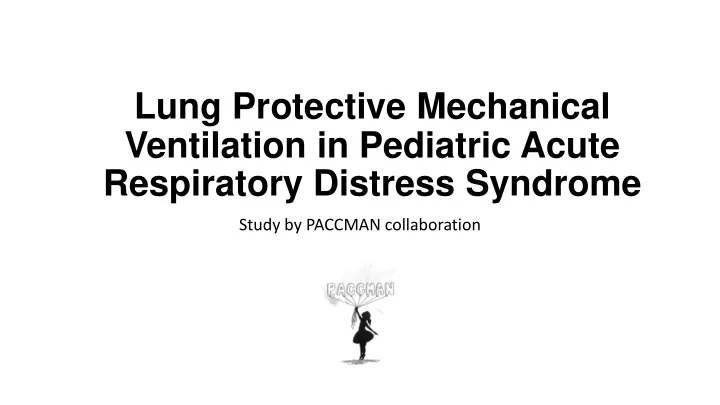

Lung Protective Mechanical Ventilation in Pediatric Acute Respiratory Distress Syndrome Study by PACCMAN collaboration
Background • Acute respiratory distress syndrome (ARDS) is recognized as the most severe form of lung injury with oxygenation failure • The only available treatment is supportive MV • MV in itself has the potential to initiate and aggravate lung injury • Led to development of lung-protective mechanical ventilation (LPMV) strategies which aim to minimize ventilator induced lung injury
Background • PARDS mortality in Asia (30%) is higher than global mortality rates (17%) • Pediatric Acute Lung Injury Consensus Conference (PALICC) recommendations were developed in 2015 • Compliance to recommendations is poor: • 25% with PIP>28cmH2O • >75% with TV>6ml/kg • >50% do not observe permissive hypoxia • >50% do not observe permissive hypercarbia • Could this account for the high mortality rate?
Aims and Hypothesis • Aim 1 : to determine if a pragmatic LPMV protocol applied to patients with PARDS over the first 7 days of disease reduces mortality • Hypothesis 1 : LPMV deployed in the form of a pragmatic ventilation protocol in the first 7 days of PARDS reduces mortality by one-third
Aims and Hypothesis • Specific aim 2: To determine if the level of adherence to LPMV elements is greater after the implementation of the LPMV protocol • Hypothesis 2: The level of adherence to LPMV elements in the first 7 days of PARDS as measured by an adherence score, is greater after the implementation of the LPMV protocol
Aims and Hypothesis • Specific aim 3: To determine if the level of adherence to LPMV elements applied to patients with PARDS over the first 7 days of disease reduces mortality • Hypothesis 3: The level of adherence to LPMV elements in the first 7 days of PARDS as measured by an adherence score, is associated with reduced mortality.
Significance • This study will determine the impact of a PARDS MV bundle on mortality and other clinical outcomes (RESEARCH) • This study will improve adherence to PARDS MV guidelines advocated by international authorities (QUALITY) • This study will standardize MV practices in PARDS laying the foundation for more comparable trials in the future (FUTURE RESEARCH)
Methodology • Multi-center, before-and-after comparison study • Recruitment of patients with PARDS will be based on the PALICC definition • Recruitment period approximately 4years: • Baseline (control) data can be collected retrospectively/prospectively in the 2-year period prior to bundle implementation • Bundle implementation with 1-month wash in period • Prospective data collection for the next 2-years post-implementation
Methodology • Seek approval by PICU medical and nursing stakeholders • Championed by intensivist and respiratory therapist/nurse • Training / education sessions for all PICU staff • Posters and reminders in the unit and at patient bedside • Regular updates at administrative meetings
LPMV team • Medical Site-PI Team member • Respiratory Therapist representative (optional) Team member Team member • Nursing representative Team member Team member
Screening
LPMV targets Ventilation Targets Tidal volume All patients 3-6ml/kg predicted body weight Peak/ plateau pressure All patients Max 29-30cm H 2 O Permissive hypercapnia pH 7.20-7.30* Oxygenation Targets Permissive hypoxia Mild PARDS SpO 2 92-97% Moderate/severe PARDS SpO 2 88-92%* Positive end expiratory Incremental FiO2/PEEP combinations FiO 2 .30 .40 .40 .50 .50 .60 .70 pressure PEEP 5-7 5-7 8 8 10 10 10 FiO 2 .70 .70 .80 .90 .90 .90 1.0 PEEP 12 14 14 14 16 18 18
Preliminary Data from KKH • Lung Protective Mechanical Ventilation Strategies in Pediatric Acute Respiratory Distress Syndrome; single centre (completed) Total No LPMV LPMV Outcomes p value (N = 132) (N=69) (N=51) Mortality 28 (21.2) 18 (26.1) 10 (15.9) 0.152 Ventilator-free days 17.5 (0.0, 23.0) 19.0 (0.0, 23.0) 16.0 (2.0, 23.0) 0.697 PICU-free days 14.0 (0.0, 21.0) 16.0 (0.0, 22.0) 13.0 (0.0, 21.0) 0.233
Preliminary Data – PACCMAN collaboration • Risk Stratification in Pediatric Acute Respiratory Distress Syndrome: A Multicenter Observational Study (completed) • Study design: Retrospective multicenter (n=10 sites) • Patients: PARDS • Intervention: NA Demonstrated variability in • Outcome: Mortality management and outcomes Outcomes Total (n=373) Mild (n=89) Moderate (n=149) Severe (n=135) P value Ventilator free days 16 (0, 23) 22 (17, 25) 16 (0, 23) 6 (0, 19) < 0.001 Duration of MV 9 (4, 16) 6 (3, 9) 10 (5, 16) 11 (5, 21) < 0.001 PICU free days 14 (0, 22) 19 (11, 24) 15 (0, 22) 5 (0, 20) < 0.001 Duration of PICU stay 11 (6, 22) 9 (5, 16) 12 (7, 24) 13 (6, 25) 0.010 PICU mortality 113 (30.3) 11 (12.4) 046 (30.9) 056 (41.5) < 0.001 100-day mortality 126 (39.7) 14 (18.7) 50 (39.1) 62 (54.4) <0.001
PARDSProAsia study Phase I (in progress) Phase II (current proposal) • Study design: Prospective observational • Study design: Before-after comparison multicenter (n=16 sites) design • Patients: • Patients: PARDS PARDS • Intervention: NA (standard care) • Intervention: LPMV bundle • Outcome: • Outcome: Mortality Mortality • Aims: • Aims: • Establish reliable screening process for • Hypothesis testing 100% identification • Determine recruitment rate • Establish feasibility of data collection tool • Confirm baseline ventilation management
Potential Challenges • Adherence to protocol elements in the pre-bundle arm? • If this is high, comparison will be difficult • Data Quality • Pre and post data need to be comparable • Secular Trend • The longer the study, the greater the risk of secular trend biasing results • Staggering the protocol start time in each center will help • Large sample size • Assuming 1/3 risk reduction (from 25% to 17%), 16 centers with variability in number of subjects and mortality, approximately 500 in each pre/post arm
Funded by Pediatric Academic Clinical Programme Singhealth under grant reference number PAEDSACP-TCL/2020/RES/001
Recommend
More recommend